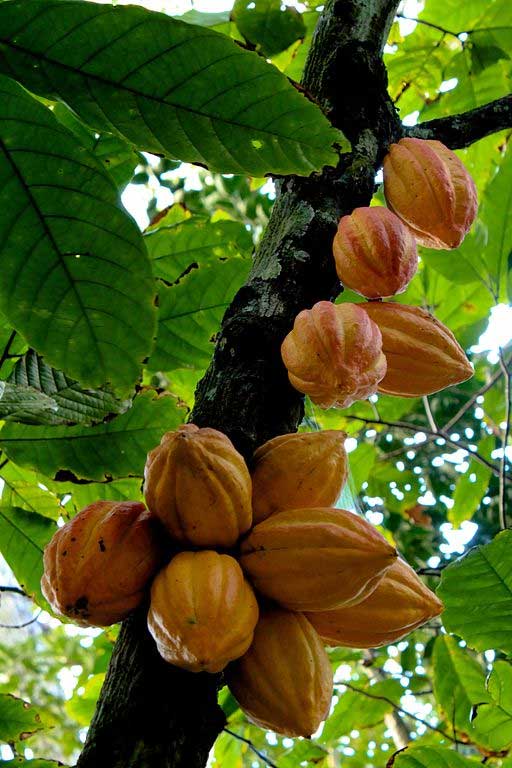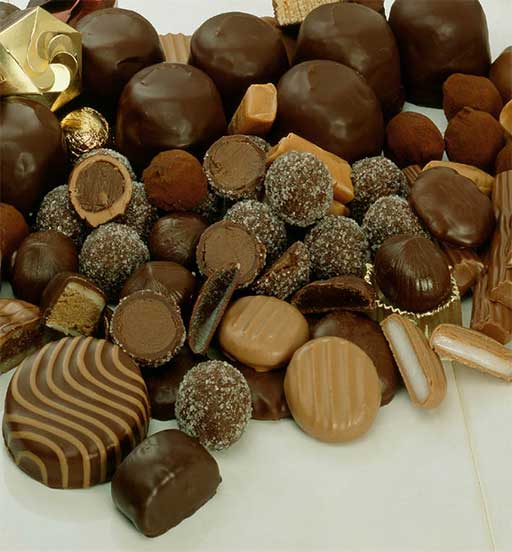The Tree of Love: a natural history of chocolate
It’s impossible for a parent to choose a favorite child—or at least that’s what I tell my kids—and it’s almost as difficult for an arborist to pick a single best-liked tree. For different reasons, I have many pet species. One of the, um, apples of my eye is a species I’ve never laid eyes on, but it’s one I’ve appreciated since early childhood.

Cacao tree (Theobroma cacao) with fruit. Photo: Luisovalles, Creative Commons, some rights reserved
Native to Central America, the cacao tree (Theobroma cacao to arborists) grows almost exclusively within twenty degrees latitude either side of the equator (in other words, where most of us wish we were about now). The seeds of the cacao tree have been ground and made into a drink known by its Native American (probably Nahuatl) name, chocolate, for as many as 4,000 years.
The cacao is a small tree, about 15-20 feet tall, bearing 6- to 12-inch long seed pods. Packed around the 30-40 cacao beans in each pod is a sweet gooey pulp, which historically was also consumed. After harvest, cacao beans go through a fermentation process and are then dried and milled into powder.
In pre-contact times chocolate was a frothy, bitter drink often mixed with chilies and cornmeal. Mayans and Aztecs drank it mainly for its medicinal properties (more on that later). In the late 1500s, a Spanish Jesuit who had been to Mexico described chocolate as being “Loathsome to such as are not acquainted with it, having a scum or froth that is very unpleasant taste.” It’s understandable, then, that it was initially slow to take off in Europe.
Chocolate became wildly popular, though, after brilliant innovations such as adding sugar and omitting chili peppers. Another reason for its meteoric rise in demand is that it seemed to have pleasant effects. One of these was similar to that of tea or coffee. There isn’t much caffeine in chocolate, but it has nearly 400 known constituents, and a number of these compounds are uppers.
Chief among them is theobromine, which has no bromine—go figure. It’s a chemical sibling to caffeine, and its name supposedly derives from the Greek for “food of the gods.” Even if people knew it more closely translates to “stink of the gods,” it’s unlikely it would put a damper on chocolate sales.
These days chocolate is recognized as a potent antioxidant, but throughout the ages it’s had a reputation for being an aphrodisiac. I assume this explains the tradition of giving chocolate to one’s lover on Valentine’s Day. Does chocolate live up to its rumored powers? Another stimulant it contains, phenylethylamine (PEA), may account for its repute.
Closely related to amphetamine, PEA facilitates the release of dopamine, the “feel good” chemical in the brain’s reward center. Turns out that when you fall in love, your brain is practically dripping with dopamine. Furthermore, at least three compounds in chocolate mimic the effects of marijuana. They bind to the same receptors in our brains as THC, the active ingredient in pot, releasing more dopamine and also serotonin, another brain chemical associated with happiness.

Photo: Klaus Hopfner, Creative Commons, some rights reserved
Don’t be alarmed at this news; these things are quite minimal compared to what real drugs can do. Consuming chocolate has never impaired my ability to operate heavy machinery (lack of training and experience have, though).
Most people would agree that chocolate is no substitute for love, but these natural chemical effects may be why romance and chocolate are so intertwined. Well, that and marketing, I suppose.
Dogs can’t metabolize theobromine very well, and a modest amount of chocolate, especially dark, can be toxic to them. This is why you shouldn’t get your dog a box of chocolates on Valentine’s Day, no matter how much you love them. And assuming it’s spayed or neutered, your pooch won’t benefit from any of chocolate’s other potential effects anyway.
Paul Hetzler is a horticulture and natural resources educator with Cornell Cooperative Extension of St. Lawrence County








Love that photo!
The real-life tree with those colorful pods looks almost made-up.
But (thankfully!) it’s oh-so-real. Thanks for a good read.